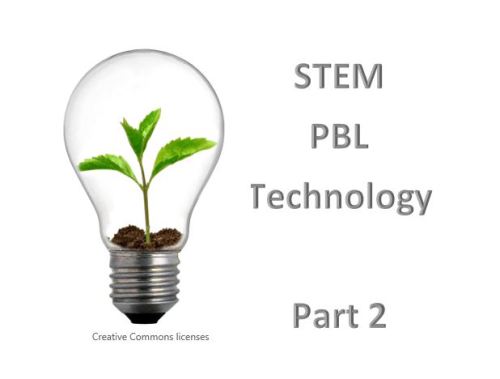Part 2: STEM, STEAM, Makers: Over 40 Amazing STEM Resources


Welcome to this second post in a series that brings STEM, STEAM, and Maker Space together with Project Based Learning and proper technology integration in the classroom. You will discover around one hundred resources in this series along with some great ideas for finding student success. Before reading, please take a moment to subscribe by email or RSS and also give me a follow on Twitter at mjgormans. I promise you will find some great information coming your way in the posts that follow…So sign up now and please pass this on with a retweet. – Mike Gorman (https://21centuryedtech.wordpress.com/)
Part 2: STEM, STEAM, Makers: Over 40 Amazing STEM Resources
Science – STEM Resources
- Science Net Links – A premiere site for STEM resources. What a wonderful place for educators to find quality teaching tools, interactives, podcasts, and hands-on activities, and best of all… it’s free!
- PHet – These are interactive simulations from the University of Colorado in Boulder. They include a large selection of simulations in biology, earth science, physics, chemistry, and math. On a Teacher Page, you can browse for teacher created activities that go with a simulation. Best of all, you can download simulations to a local computer if you do not wish to rely on an internet connection.
- NSDL – The National Science Digital Library has some outstanding resources that include numerous links to some great STEM programs and organizations.
- Understanding Science… How Science Really Works – Discover this assembly of resources to help educators increase student understanding of nature and the process of science. There is a collection of wonderful lesson plans, teaching tips, and pedagogical strategies You can also visit a Teacher’s Lounge or explore the all-level resources. It is fun to discover how science really works.
- New York Hall of Science – Wonderful site presents 450 exhibits, demonstrations, workshops and participatory activities that explain science, technology, engineering, and math.
- MIT and Khan Science – Khan has so much more than Math, in fact… visit this Science site that includes resources with Khan Partner MIT K-12. Here you will find great lessons involving Physics, Natural Science, Resources, and Measurement. This is an area that may just help you flip your STEM classroom
- HHMI BioInteractive – It really is through innovative science education programs that HHMI seeks to strengthen education in biology,and related sciences from elementary school to graduate studies and beyond. Educators will find a wealth of information and resources including sources from Biology, Chemistry, Physiology, and even 3D Printing. There is something for just about any STEM classroom that is ready to engage students.
- Click To Science –The basic foundation of Click2Science is their 20 Skills to Make STEM Click. These are skills they claim are necessary to implement science effectively in an out-of-school time settings. Click2Science really is an indispensable resource for staff working directly with youth and for coaches and trainers working with staff. It also a resource that classroom teachers may just want to get some STEM ideas from.
- MIT K12 – This site was built around a simple idea: K12 educators and MIT should be working together to make movies for K12 students. Educators submit ideas for experiments or demonstrations they would like to see an MIT student perform and explain in a short video. MIT students can then “check out” these assignments or they can come up with their own ideas and check them out themselves. The result is an amazing K12 STEM video online to be used in the classroom.
- NASA Wavelength – Now is the time for you to explore NASA Wavelength, an initiative dedicated to providing education a digital collection of Earth and space science resources for educators of all levels. The incredible resources at Nasa Wave Length were developed through funding of the NASA Science Mission Directorate (SMD). You will find that all the resources have undergone a rigorous peer-review process.
Technology STEM Resources
- Code – Educators interested in computer programming need to visit this site dedicated to expanding participation in computer science. The vision of CODE is that every student in every school should have the opportunity to learn computer programming. STEM educators will discover ways to integrate core curriculum in education, alongside other science, technology, engineering, and mathematics (STEM) courses, such as biology, physics, chemistry and algebra.
- Scratch – With Scratch, kids can program their own interactive stories, games, and animations — and share your creations with others in the online community. Scratch helps young people learn to think creatively, reason systematically, and work collaboratively . All of this is possible while essential skills for life in the 21st century are facilitated. Scratch is a project of the Lifelong Kindergarten Group at the MIT Media Lab. It is provided free of charge.
- Computer Science Unplugged – CS Unplugged is a wonderful collection of free learning activities that teach Computer Science through engaging games and puzzles that use cards, string, crayons and lots of running around. The activities introduce students to underlying STEM concepts such as binary numbers, algorithms, and data compression, separated from the distractions and technical details we usually see with computers.
- Tynker – Along with great programming opportunities, the Hour of Code activities are designed to teach students computational thinking and the basics of computer programming. Students solve each puzzle by programming visual code blocks to achieve a goal.
- Accelerator Nation – It is time for you to bring aerodynamics to life in your STEM Classroom. You and your students can dive into hands-on aerodynamics experiments and dynamic STEM activities that support core science lessons in force, momentum, and speed. Along with the main link… check out this special area for teachers
- National STEM Video Game Challenge – You and your students will enjoy this site inspired by the Educate to Innovate Campaign to promote a renewed focus on Science, Technology, Engineering, and Math (STEM) education. The National STEM Video Game Challenge is a multi-year competition whose goal is to motivate interest in STEM learning among America’s youth by tapping into students’ natural passion for playing and making video games.
- Tech Museum of Innovation – Check out these challenges available from an amazing museum. While you are at the site check out all the other possible resources that might just work for your classroom.
- Tech Rockets – Students ages 10 to 18 can create a Tech Rocket account and gain access to amazing tech courses. These include Python, iOS, Java, Minecraft, 3D printing. Each course contains lessons, support materials, and interactive challenges. Students can even gain points and badges along the way.
- NASA Kids Club – Students take part in some amazing technology based missions as they engage in various missions. This is a place where students learn and enjoy as they possibly even blaze through space.
- Center for Game Science – Discover this unique site that has created games focused on the importance of scientific discovery, discovering optimal learning pathways for STEM education, cognitive skill training , and unique games that explore collective over individual intelligence.
- Smithsonian Science and Technology – Make sure you take the time to look at these lesson plans that emphasize the idea of science and technology through culture and history. You will find great ideas!
Engineering STEM Resources
- Design Squad Nation – Another great service from PBS filled with some entertaining and engaging ways to integrate STEM into any classroom. Teachers can explore and use Design Squad Nation activities, animations, video profiles, and episodes in classrooms and after-school programs, in libraries and museums, at events and at home.
- Engineer Your Life – This engaging website is the centerpiece of a national campaign, and is meant for high school girls and the adults in their lives (parents, counselors, teachers, and other educators) who want to learn more about what life and work are like for engineers. It is a great place to explore outstanding engineering possibilities.
- Teach Engineering – This is a comprehensive collaborative project between faculty, students, and teachers associated with five founding partner universities, with NSF National Science Foundation funding. This real world collection continues to grow and evolve with new additions submitted from more than 50 additional contributors, a cadre of volunteer teacher and engineer reviewers, and feedback from teachers who use the curricula in their classrooms.
- Discover Engineering – This organization coalition of volunteer engineer professionals works together to celebrate engineering and give students hands-on experiences with engineering.
- eGFI Dream Up The Future – Be ready to discover a variety of tools to boost your students’ math and science skills, enliven the classroom with engineering projects, expand your own professional horizons and stay informed. There is also an amazing free newsletter with updated features that will arrive in your in-box every month. This is a site that is a must visit for any STEM teacher.
- EIE – Engineering is Elementary EIE) supports educators and children with curricula and professional development that develop engineering literacy. EiE serves children and educators in grades K- 8 with research-based, teacher-tested curriculum materials for schools and out-of-school time programs. The program also helps teachers build skills and confidence in teaching engineering and technology in their professional development workshops.
- The Lemlinson Center -Take a moment to visit this center that showcases the study of invention and innovation. It is part of the National Museum of American History, Smithsonian Institution, the center documents, interprets, and disseminates information about invention and innovation; encourages inventive creativity in young people; and fosters an appreciation for the central role that invention and innovation play in the history of the United States.
- Cooper Hewitt Lesson Plans – Take a look at the design possibilities covering all subject areas and grade levels. There will surely be something to promote design thinking!
- Try Engineering – Here a place to visit for the lastest information, resources, and research. It will provide numerous ideas to bring engineering to the classroom.
- The Engineering Place – This might be the right place to get the idea you need. There are wonderfullesson plans for K-8 students.
Math STEM Resources
- MathSite – You will enjoy this amazing interactive journey in math. The exhibits found at MathSite are intended for people of all ages who are interested in or are curious about mathematics. No specialized mathematical knowledge or special expertise is assumed. You will find it a place to see, hear, and do mathematics.
- Emergent Math – Looking for ideas that just might spark a PBL math idea? Emergent Math is dedicated to brainstorming interesting and dynamic math problems and projects. The facilitator of the blog is employed by the New Technology Network of Schools. The posts really do allow for real mathspiration (inspirational combined with math). As stated in the blog, “interesting math problem/project can come in the form of a picture, a video, a tweet, something your child says, etc”. This blog really does attempt to use all of the preceding ideas, plus more! The posts generate ideas on how these concepts just might fit in the classroom and/or provide some driving/guiding questions. The best place to begin your exploration is at the first page of the blog and read the index! You will enjoy your immersion in Math!
- Exploring Space Through Math – This amazing NASA site promotes inquiry through real world applications. Students assume the role of NASA scientists, engineers and researchers who work in teams to accomplish tasks. These projects promote cooperative learning, problem-solving and the use of technology. The problems in this project follow the 5-E’s Instructional Model with a segment for each phase of instruction – Engage, Explore, Explain, Extend and Evaluate. The projects cover the scope of Algebra I, Algebra II, Geometry, and Precalculus.
- Annenberg Learner Math Lessons – Annenberg Learner uses media and telecommunications to advance excellent teaching in American schools. This mandate is carried out chiefly by the funding and broad distribution of educational video programs with coordinated Web and print materials for the professional development of K-12 teachers. The math lessons could be a footprint to a PBL unit or scaffolding for an entire PBL. While at the site… take a look at the interactives.
- Figure This – This wonderful site is the work of the National Council of Teachers of Mathematics, in cooperation with the National Action Council for Minorities in Engineering, Widmeyer Communications, and the Learning First Alliance. Its mission is to challenge middle school mathematics and emphasizes the importance of high-quality math education for all students. While it was created to allow for family interaction, it is also figures into the Math PBL classroom. The site allows students to have the opportunity to face some every day real life math challenges.
- Mathematical Moments – Authenticity is important in Math PBL. It seems that Math educators are always looking for ways they can show how math is used in the world around us. Discover a site that will help you achieve this goal of real world application. The site is cleverly titled Mathematical Moments and it is well worth the time! It contains free printable posters that are 8.5″ x 11″ PDF documents. These informational posters are available on many different topics in science, nature, technology, and human culture. As you take a closer look many of these posters note that many have a link to some short feature podcast interviews with experts in the field. These posters and podcast could spark the idea for a PBL math unit that brings authenticity into your math teaching.
- MIT Blossoms – All of the lessons in the MIT Blossoms library have been contributed by BLOSSOMS partners from around the world. There is a watch the Teacher’s Guide Video Segment included with each lesson to learn more about it. The final segment of each BLOSSOMS video lesson is a one-on-one conversation between the teacher and the “virtual teacher.” Best of all, these lessons can be part of a PBL unit. The provided link brings you to the Math (English Language) Section.
- Get The Math – Get the Math is about algebra in the real world. See how professionals use math in music, fashion, video games, restaurants, basketball, and special effects. Then take on interactive challenges related to those careers.
- Mathalicious – While this is a paid site you will find several free projects on the homepage. Perhaps you will find that the paid lessons are really well worth it! This site does demonstrate that math is about more than just numbers and equations. Students find that math is a tool to explore the world around us. Mathalicious provides teachers with lessons that help them teach math in a way that engages their students–in a way that helps students understand how the world works. Lessons are aligned to Common Core Standards and explore real life questions.
- TedEd – The makers of TED… these really are some wonderful flipped lessons with formative tools built in. These are definite lessons worth sharing! You can even make your own
- How to Smile – Discover this group of science museums dedicated to bringing science, technology, engineering, and math (STEM) out of the academic cloister and into the wider world. Find new ways to teach kids about math and science. Discover activities that meet you where you live, whether your “classroom” is an active volcano, the shark tank at the local aquarium, or your own kitchen table. SMILE is collecting the best educational materials on the web and creating learning activities, tools, and services.
Next in the Series…Great STEM Competitions !
Tools and ideas to transform education. Sign up below.
cross-posted at 21centuryedtech.wordpress.com
Michael Gorman oversees one-to-one laptop programs and digital professional development for Southwest Allen County Schools near Fort Wayne, Indiana. He is a consultant for Discovery Education, ISTE, My Big Campus, and November Learning and is on the National Faculty for The Buck Institute for Education. His awards include district Teacher of the Year, Indiana STEM Educator of the Year and Microsoft’s 365 Global Education Hero. Read more at 21centuryedtech.wordpress.com.
